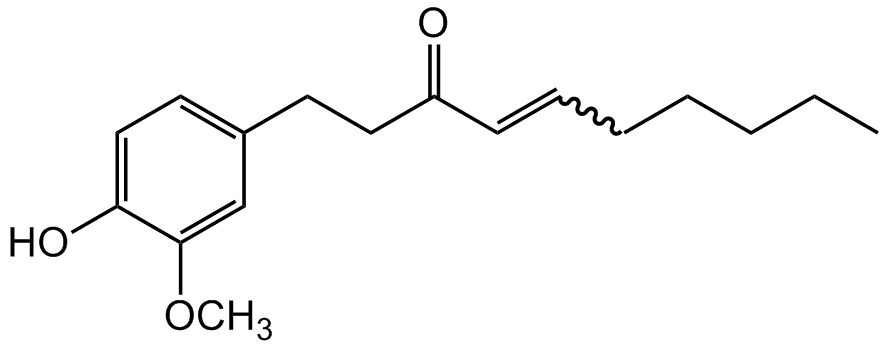Shogaol
| Code | Size | Price |
|---|
| CDX-S0279-M010 | 10 mg | £121.00 |
Quantity:
| CDX-S0279-M025 | 25 mg | £237.00 |
Quantity:
Prices exclude any Taxes / VAT
Overview
Host Type: Plant
Regulatory Status: RUO
Shipping:
AMBIENT
Storage:
Short Term: +20°C, Long Term: +4°C
Images
Documents
Further Information
Alternate Names/Synonyms:
(6)-Shogaol; 1-(4-Hydroxy-3-methoxyphenyl)-4-decen-3-one; CCRIS2038
Appearance:
Colourless to yellow liquid.
CAS:
555-66-8
EClass:
32160000
Form (Short):
liquid
GHS Symbol:
GHS07
Handling Advice:
Protect from light and moisture.
Hazards:
H302
InChi:
InChI=1S/C17H24O3/c1-3-4-5-6-7-8-15(18)11-9-14-10-12-16(19)17(13-14)20-2/h7-8,10,12-13,19H,3-6,9,11H2,1-2H3/b8-7+
InChiKey:
OQWKEEOHDMUXEO-BQYQJAHWSA-N
Long Description:
Chemical. CAS: 555-66-8. Formula: C17H24O3. MW: 276.37. Shogaol is a pungent bioactive component of ginger (Zingiber officinale Roscoe) with anti-inflammatory, anticancer, antioxidant, neuroprotective, antidiabetic, cardioprotective and antimicrobial properties. The anticancer activity is associated with the induction of apoptosis in cancer cells through the production of reactive oxygen species and the activation of caspase, impairment of tubulin polymerization, downregulation of STAT3 and NF-kappaB signaling, inhibition of the expression of inflammatory mediators and suppresseion of Toll-like receptor signaling. It also has been shown to induce autophagy and activate peroxisomal proliferator activated receptor gamma (PPARgamma). 6-Shogaol can also activate both TRPV1 and TRPA1 channels. 6-Shogaol inhibits the NF-kappaB and NLRP3 signaling pathways.
MDL:
MFCD01736094
Molecular Formula:
C17H24O3
Molecular Weight:
276.37
Package Type:
Vial
Product Description:
Shogaol is a pungent bioactive component of ginger (Zingiber officinale Roscoe) with anti-inflammatory, anticancer, antioxidant, neuroprotective, antidiabetic, cardioprotective and antimicrobial properties. The anticancer activity is associated with the induction of apoptosis in cancer cells through the production of reactive oxygen species and the activation of caspase, impairment of tubulin polymerization, downregulation of STAT3 and NF-kappaB signaling, inhibition of the expression of inflammatory mediators and suppresseion of Toll-like receptor signaling. It also has been shown to induce autophagy and activate peroxisomal proliferator activated receptor gamma (PPARgamma). 6-Shogaol can also activate both TRPV1 and TRPA1 channels. 6-Shogaol inhibits the NF-kappaB and NLRP3 signaling pathways.
Purity:
>98% (HPLC)
Signal word:
Warning
SMILES:
OC1=CC=C(CCC(/C=C/CCCCC)=O)C=C1OC
Solubility Chemicals:
Soluble in DMSO (10mg/ml).
Source / Host:
Plant
Transportation:
Non-hazardous
UNSPSC Category:
Natural Products/Extracts
UNSPSC Number:
12352200
Use & Stability:
Stable for at least 2 years after receipt when stored at +4°C.
References
(1) M. Suekawa, et al.; J. Pharmacobiodyn. 7, 836 (1984) | (2) M.H. Pan, et al.; Mol. Nutr. Food Res. 52, 527 (2008) | (3) K. Ishiguro, et al.; FEBS Lett. 582, 3531 (2008) | (4) S.J. Park, et al.; Biosci. Biotechnol. Biochem. 73, 1474 (2009) | (5) J.Y. Hung, et al.; J. Agric. Food Chem. 57, 9809 (2009) | (6) E.P. Sabina, et al.; Food Chem. Toxicol. 48, 229 (2010) | (7) S.K. Ha, et al.; Neuropharmacology 63, 211 (2012) | (8) R. Hu, et al.; PLoS One 7, e39664 (2012) | (9) F. Li, et al.; Food Chem. 135, 332 (2012) | (10) B.S. Tan, et al.; Cancer Lett. 336, 127 (2013) | (11) P. Rebellato & M.S. Islam; JOP 15, 33 (2014) | (12) A. Saha, et al.; Cancer Prev. Res. 7, 627 (2014) | (13) G. Park, et al.; Toxicol. Appl. Pharmacol. 310, 51 (2016) | (14) Y. Xu, et al.; Biomed. Pharmacother. 97, 633 (2018) | (15) J.H. Lee, et al.; Front. Cell Infect. Microbiol. 8, 299 (2018) | (16) T.C. Chen, et al.; Cell Biosci. 10, 5 (2020)



